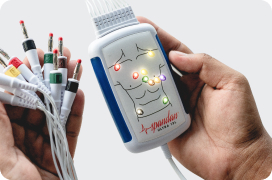
Author:- Mr. Ritesh Sharma
An electrocardiogram is an extremely essential screening test when it comes to emergencies or general medical settings. It captures the electrical activity of the heart which helps in identifying various heart abnormalities ranging from temporary heart palpitations to dangerous cardiac arrhythmias to life-threatening heart attacks. An ECG machine consists of several components and ECG leads are one of them. The optimal ECG Lead Placement is necessary to generate accurate results when taking an ECG test.
Although healthcare professionals normally have a good idea of how to do ECG lead placement on the patient’s body to capture the electrical impulses generated by the heart from various angles, small mistakes can still happen. Therefore, it is important to keep some important tips in mind when performing an ECG test and connecting the ECG leads.
The accuracy of an electrocardiogram test largely depends on the connection of the ECG electrodes to the leads. Therefore, in this blog, we will cover all the aspects of ECG lead placement. Furthermore, we will also share informative tips that will help you perform an ECG test without any hassle. Hence, this blog will be a helpful read for clinicians and general people alike.
Understanding ECG Lead Placement
Before diving into the specifics of lead placement, it is important to understand the basics of ECG leads. A standard 12-lead ECG records the electrical activity of the heart from 12 different perspectives using ten electrodes: four limb electrodes and six precordial (chest) electrodes.
Limb Leads
- Right Arm (RA): Usually placed just below the right clavicle.
- Left Arm (LA): Usually placed just below the left clavicle.
- Right Leg (RL): Often used as a ground electrode and placed on the lower right torso.
- Left Leg (LL): Placed on the lower left torso.
Precordial Leads
- V1: Fourth intercostal space at the right border of the sternum.
- V2: Fourth intercostal space at the left border of the sternum.
- V3: Midway between V2 and V4.
- V4: Fifth intercostal space at the midclavicular line.
- V5: Horizontal to V4 at the anterior axillary line.
- V6: Horizontal to V4 at the midaxillary line.
Correct placement of these electrodes is essential for obtaining a clear and accurate ECG tracing.
Importance of Proper ECG Lead Placement
Proper ECG lead placement is critical for several reasons:
- Accuracy of Diagnosis: Misplacement can lead to misdiagnosis of cardiac conditions like myocardial infarction, arrhythmias, and electrolyte imbalances.
- Consistency: Standardized placement ensures that ECGs taken at different times or by different healthcare professionals are comparable.
- Reliability: Accurate readings reduce the need for repeat ECGs, saving time and resources.
Tips for Accurate ECG Lead Placement
Here are key tips to ensure optimal ECG lead placement:
1. Familiarize with Anatomical Landmarks
Understanding the anatomical landmarks is crucial. For example, the fourth intercostal space can be identified by palpating the rib cage starting from the second rib, which is adjacent to the sternal angle (the palpable bump where the manubrium meets the body of the sternum).
2. Clean and Prepare the Skin
Proper skin preparation ensures good electrode contact. Clean the skin with alcohol swabs to remove oils and dirt. Shaving or trimming excessive chest hair might be necessary to improve electrode adhesion.
3. Correct Electrode Placement
Adhere strictly to the standard positions:
- Place limb electrodes on fleshy, non-bony areas to reduce muscle noise.
- Ensure precordial electrodes are precisely positioned using intercostal spaces and anatomical lines as guides.
4. Avoid Placing Electrodes Over Bones
Electrodes placed over bony areas like the sternum or ribs may not pick up the electrical activity as accurately as those placed over soft tissue.
5. Use the Right Type of Electrodes
Use adhesive electrodes that are appropriate for the patient’s skin type and condition. In cases of diaphoresis or excessive sweating, consider using electrodes with stronger adhesive properties.
6. Check for Symmetry
Ensure the limb leads are symmetrically placed. For instance, both arm electrodes should be placed at the same level and not asymmetrically.
7. Confirm Lead Placement
After placing the electrodes, double-check their positions. Minor adjustments might be necessary to ensure they are in the correct anatomical locations.
8. Educate the Patient
Inform the patient about the procedure and ask them to stay still and avoid talking during the recording to minimize artifacts.
9. Minimize Interference
Keep the ECG machine and leads away from potential sources of electrical interference, such as other medical equipment or cell phones.
10. Recheck During Long Recordings
For extended monitoring or during exercise stress tests, periodically check the electrodes to ensure they haven’t moved or detached.
Common Errors in ECG Lead Placement
Even with careful attention, errors can occur. Some common mistakes include:
- Misplacement of V1 and V2: These leads are sometimes placed too high or too low, leading to inaccurate readings.
- Reversal of Limb Leads: Incorrect placement or reversal of limb leads can result in misleading ECG patterns.
- Improper Skin Preparation: Skipping skin preparation can lead to poor electrode contact and noisy recordings.
Troubleshooting ECG Artifacts
Artifacts can obscure the ECG tracings, making interpretation difficult. Common artifacts include:
- Muscle Tremor: Involuntary muscle movements can cause baseline wander. Ask the patient to relax and stay still.
- AC Interference: Electrical interference from nearby devices can cause 60 Hz artifact. Ensure the ECG machine is properly grounded and keep it away from electrical devices.
- Poor Electrode Contact: Loose or dried-out electrodes can cause intermittent contact. Replace electrodes if necessary.
In conclusion, proper ECG lead placement is extremely crucial to successfully perform an ECG test and generate accurate results. If the lead placement is not proper then even an abnormal ECG might appear to be normal or vice versa and this can lead to serious complications. So, keep the aforementioned tips in mind before performing an ECG test.




